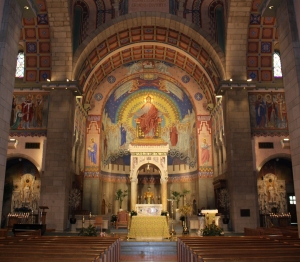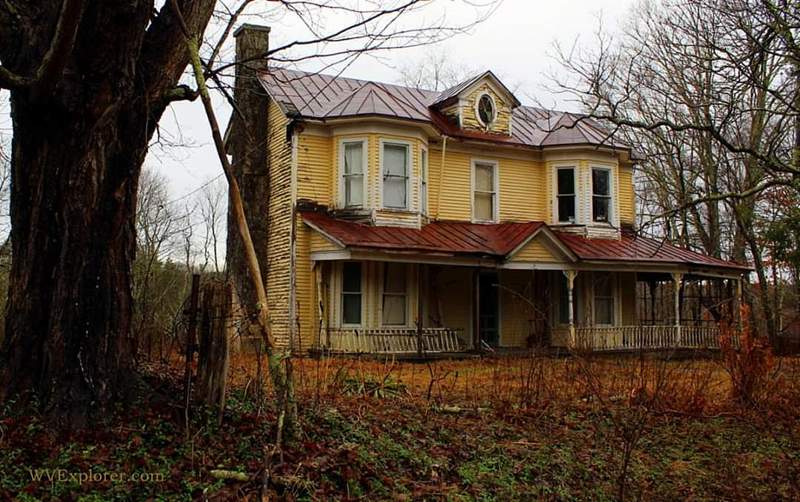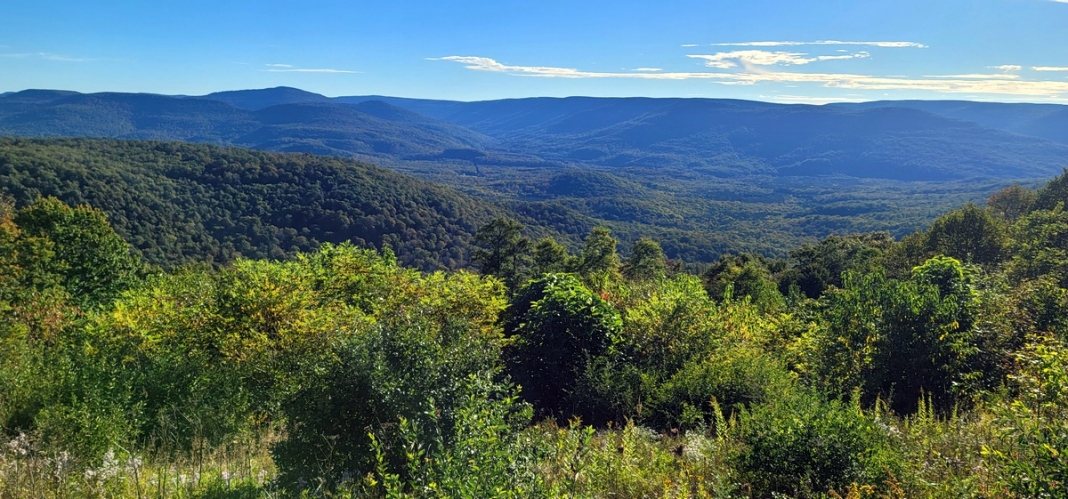GLEN DALE, W.Va. — Lone graves aren't rare in West Virginia. Many pioneers and settlers perished in its mountains, far from friends and family. However, one burial stands out as a remarkable and mysterious example.
The grave of an unknown priest on a ridge high above Middle Grave Creek near the Ohio River illustrates religious intolerance in what's now West Virginia during its settlement.
According to historian and preservationist John Smith, who helped restore the headstone, the grave is remarkable in large part because it is that of a priest of the Roman Catholic faith, who was buried at a time when Catholics were few in the region.
"Back then, Roman Catholics weren't permitted in Virginia—and in what's now West Virginia," Smith said.
"There are many of them now, especially here in the state's northern panhandle, where immigrants from eastern Europe came to work in the mines and steel mills, and the Irish on the railroads. But even in the early 1800s, Catholics were few."
Smith cited a passage from Myers' History of West Virginia, published in 1915, that outlined the situation.
"From the beginning of the first settlement in Virginia in 1607 up to 1785, the Episcopal Church was the established church under the English and Virginia laws; and while a few of the other Protestant denominations were tolerated under certain cumbrous restrictions, the teaching of the Roman Catholic doctrine was prohibited in the state. A Catholic priest was not even permitted to visit the colony; to do so subjected him to arrest, fine, and imprisonment.
"A law was passed in Virginia in 1641 imposing a fine of one thousand pounds of tobacco against any Catholic who accepted any office of trust or profit. So severe was the treatment of the Catholics that when the law was repealed, placing all church denominations on an equality, there was but a mere handful of Catholics in the state.
A proclamation by Sir William Gooch, 1st Baronet and Governor of Virginia in 1733, illustrates the feeling toward the Catholics at that time:
WHEREAS, It has been represented to me in Council that several Roman Catholic priests are lately come from Maryland to Fairfax County in this colony, and are endeavoring by crafty insinuations to seduce his majesty's good subjects from their fidelity and loyalty to his majesty King George, and his royal house, I have, therefore, thought fit, with the advice of his majesty's council, to issue this proclamation, requiring all magistrates, sheriffs, and constables, and other of his majesty's liege people within this colony, to be diligent in apprehending and bringing to justice the said Romish priests, or any of them, so that they may be prosecuted according to law.
Myers, in his history, went on to express that even after the repeal of anti-Catholic laws, Catholicism was slow to take hold in a territory inhabited mainly by people of English, Scottish, and Scotch-Irish descent.
"Notwithstanding the repeal of the obnoxious law pertaining to church restrictions in Virginia in 1785, the Catholic Church did not make much headway in western Virginia until after the Civil War. As late as 1841, the only Catholic Church in the state was located at Wheeling.
"Of course, there were considerable numbers of that faith scattered through the country, some of whom were occasionally visited by priests. It is recorded that priests ministered to their people in Monongalia. Marion, Preston, Hampshire, Kanawha, and other counties as early as 1822. A priest was stationed at Summersville, Nicholas County, in 1842, who looked after his flock in the Kanawha valley, but no church was built at Summersville until 1852. Two years previous to the construction of this church, there were only five churches in the state, namely: Wheeling, Weston, Parkersburg, Wytheville, and Kingwood.
"The Catholic population was small west of the Alleghanies until after the opening up of public works. The building of the Northwestern Turnpike from Winchester to Parkersburg, and the construction of the Baltimore & Ohio railroad were performed mainly by Irish Catholics, many of whom finally purchased land and located and reared large families along the rights of way of the improvements which they helped to make."
According to the Roman Catholic Diocese of Wheeling-Charleston, the Catholic population in West Virginia was approximately 74,759 in 2020, or about 4.1% of the state's population of 1,815,857. The Roman Catholic Church is the largest Christian Church in the world, representing about 50 percent of all Christians.
Eight Roman Catholic churches are now located in Wheeling, and altogether 14 are located in the northern panhandle.
The Grave of the Unknown Priest
The identity of the unnamed priest buried on the knee of land overlooking the Ohio Valley may never be known. However, Mary Ruth Key, who now owns the property on which the grave is located, intends to care for the site perpetually.
Key provided the following narrative prepared by Father James Daly and James A. McCulley, edited by Betty Key in 2008.
"On the basis of what we believe to be reliable information concerning the grave of an unknown priest on the farm of the Markey family, (presently Key property) which is located on Glen Dale Heights, arrangements were made to pay to it the respect and reverence due to the last resting place of one who gave his life ministering to the spiritual needs of the few scattered Catholic families residing in Marshall County.
"The Holy Name Society of St. James Parish in McMechen, West Virginia, of which Glen Dale Heights was a part, assumed the responsibility of caring for the grave.
"In the hope of discovering some tangible evidence of burial, a few members of the society (Martin Conner, James Welsh, Jim McCulley, Leo Anderson, Phil Markey, Carl, John and Matt Hazlett, Father Brady and Father Daly) reopened the grave, but it yielded nothing more indicative of burial that a portion of earth about the length and breadth of a man's body, and of a deep purple color, found in depth of between five and six feet.
"Mr. James Shuetz, custodian of Mount Calvary Cemetery in Wheeling, who examined the purple color clay, and who by virtue of his experience of exhuming bodies after long years of burial, stated that a human body was undoubtedly buried in that grave.
"Furthermore, explanation of the fact that nothing more tangible was found is due to the particular nature of the ground, which Shuetz describes as "soapstone," which would be conducive to the speedy decay of a human body. Had the body been interred in limestone ground, the bones would have been crystallized, and evidence of a more conclusive nature would have rewarded the efforts of those who opened the grave on Glen Dale Heights.
"Information given by Shuetz supports the tradition reverently preserved and carefully handed down from one generation to another in the Markey family. As evidence of their interest in the grave, we discovered the 4 cornerstones placed there at the time of burial, and the 3 maple trees planted around the grave later on by John Markey and other members of the family as an additional mark of identification. All the descendants of the Markey family now living are familiar with grave, and the identification marks placed around it by their ancestors.
"According to family tradition, so carefully preserved, relates that the missionary priest died after 2 days of illness in the home of a family named Clarke. The Clarkes then owned and occupied the farm on which the grave is located. The farm was later purchased by the Reilleys, who lived in McMechen, West Virginia, and later relocated to Glen Dale Heights. Whose great-grandchildren still live on the heights. The Markeys purchased the farm from the Reilleys.
"At the time of the priest's death, another family, the Campbells, lived on a neighboring farm. It was from these two families, the Clarkes and the Campbells, that the Markeys learned of the priest's death, the circumstances surrounding it, and the place of the burial.
"Efforts to trace the descendants of the Clarke family have been without success. The Markeys, who once owned the farm where the grave is located, came from Ireland to Pittsburgh, then Glen Dale Heights, in 1828. Philip Markey, the father of three daughters and a son, resided there. Ann and Katie Markey, Julia Chapman, and Johnny Markey were born and died on the farm. Katie Markey is the great-grandmother of the present owner, Betty Key. The same Philip Markey marked the grave by planting two locust trees, the decayed stumps of which were found with the four corner stones previously set as markers by either the Clarkes or the Campbells, when the grave was opened.
"The three maple trees planted by his son, John, who died in 1947 at the age of 84, still stand as a token of the reverence all family members held for this grave.
"Philip Markey, who was born on the farm, received from his parents, neighbors and the Campbells many details associated with the visits, activities, sickness, death and burial of this now unknown priest.
"Unfortunately, there are no records or documents to preserve the name or history of the unknown priest. Betty and Stanley Key purchased the property at the Marshall County Court House in 1952 in order to settle Johnny Markeys estate.
"The Holy Name Society of St. James Church in McMechen warranted enough information was gathered to build a 10-foot concrete wall and erect over it a beautiful Celtic cross dedicated to the memory of the priest, a servant of God. A prisoner of Italian descent who was a resident in the former Moundsville Penitentiary carved the cross out of white granite.
"While his name may never be known and the circumstances of his sickness and death may remain a secret, this tribute of the Holy Name Society to the lonely grave of an unknown soldier of Christ will stand as a simple and lowly monument to his memory. It will in some small way tell the price in terms of labor, sacrifice and heroism paid by priests of the past for the preservation of our ancient Faith in what was then a distant outpost of God's kingdom on earth.
"The bronze plaque placed over the grave contains the following information:
"ERECTED BY THE HOLY NAME SOCIETY OF ST.JAMES PARISH, MCMECHEN, IN THE YEAR OF OUR LORD 1954 TO THE SACRED MEMORY OF A PIONEER PRIEST WHO, MORE THAN ONE HUNDRED AND FIFTY YEARS AGO, MINISTERED TO THE SPIRITUAL NEEDS OF THE CATHOLIC PEOPLE LIVING HERE ON WHAT WAS THEN A DISTANT OUTPOST OF THE FAITH. MAY HE REST IN THE PEACE AND THE JOY OF THE OMNIPOTENT GOD WHO ALONE KNOWS HIS NAME AND WHENCE HE CAME."
Sign up to receive a FREE copy of West Virginia Explorer Magazine in your email twice weekly. Sign me up!





What a fascinating and poignant story.
I think there an error in the article concerning the number Catholic churches in WV in the early 1800s
There was, until it burned to the ground last year, a Catholic Church was on the road between Bragg WV and Sand Stone Falls. It is my understanding it was built in the late 1700s/early 1800s
That was such a beautiful church and inviting local, but it wasn't built until 1877 at about the time Irish immigrants came in work on the Chesapeake & Ohio Railroad nearby ay Hinton.
That was such a beautiful church and inviting locale, but it wasn't built until 1877 at about the time Irish immigrants came in work on the Chesapeake & Ohio Railroad nearby ay Hinton.
Very interesting story. I knew there were few members of the Catholic religion in WV even into the '50s. I have been told that most of the smaller towns have only protestant congregations.
Wonderful history lesson. This story was an excellent read.